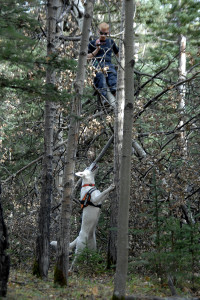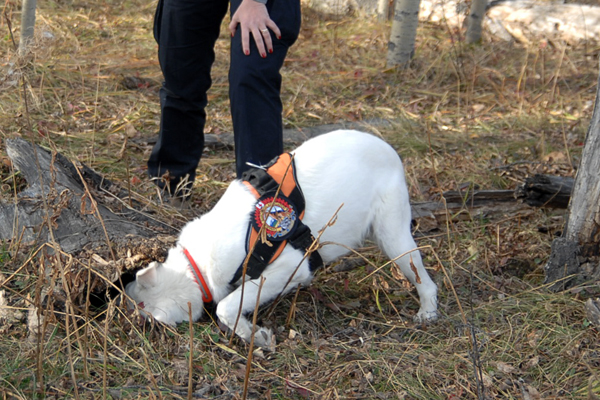
Cadaver dog teams break missing persons’ cases
Finding the body provides crucial evidence in a missing persons’ case. Was it a natural death or a murder? If the former, the find helps bring closure to the family of the deceased. If the latter, clues on or around the body can offer valuable leads to law enforcement.
So often, it’s a pair of canine nostrils that break a case.
Detectives have used human remains detection dogs since the 19th century, but only during the 1970s has law enforcement standardized training. Different countries have different regulations and training procedures for cadaver dog teams.
Meet the cadaver dog team Birgit Hilsbos & Blaze
This week, the cadaver dog team of Birgit Hilsbos and Blaze are checking in to tell about their training in Canada.
- You have lived in both Switzerland and Canada. Which country are you from and how did you come to live and work in the other?

Birgit Hilsbos: I am from Switzerland and lived almost four years in Alberta. Last December we returned to Switzerland.
- How did you get started as a cadaver dog handler?

Training with the Canadian Search Dog Association
Well, I had quite a few detours. I began my canine career as a dog walker 22 years ago. I got my first dog in 1998 and trained him in competition tracking. My second dog arrived four years later, and I competed with her in obedience, tracking, and air scenting. I apprenticed with Assistance Dog International and worked with Assistance Dogs before my third dog, Blaze, came into my life. Because of some old Swiss friends, I started doing SAR [search and rescue] with her, and became a member of the Canadian Search Dog Association. Aside from searching for human scent (missing people & evidence), the CSDA also has the cadaver profile.
- You have read my interviews of the U.S.-American cadaver dog team Cat Warren & Solo and the German team Michael Müller & Gerry. How does cadaver dog training in Switzerland and Canada compare to the United States and Germany?
The “real stuff”

In Canada we started with the “real stuff” right from the beginning. Because members of the CSDA are certified by the RCMP [Royal Canadian Mounted Police] and tasked only by law enforcement, we had a strict policy on handling cadaver material. We received parts of a burial shroud from the police, as well as other material from hospitals. I soaked a 2 x 2 cm piece of gauze with the material and put it into little tubes, sealed them – the lid has a 2 mm hole – and then introduced the scent. As soon as Blaze made the connection between the command and the scent and mastered the passive alert, I put it somewhere in the open, first in a small area, and then increased the size of the area, and either buried it or hung it in trees.
- Has your dog’s sense of smell ever surprised you?

When I first saw her doing hard surface tracking I was totally amazed. Properly trained, she will find everything I ask her for, just for the fun of a game, some treats, or simply my affection.

Thank you Birgit, for participating in this interview, and thank you Blaze, for all your hard work!
Could you imagine doing this kind of training with your dog? Why or why not?




[…] Cadaver dogs can break cases. Birgit Hilbos, a dog handler, describes how a cadaver dog team is trained in Canada with the Canadian Search Dog Association. via Birgit Hilsbos & Blaze: Cadaver Dog Team Training in Canada. […]
If a package of snausages ever goes missing, my dog will be ready to serve on the search team.
Ah, but Brian, a good cadaver dog is trained to ignore those snausages and stick to business….
Amazing work
I am interested in this line of work as I own a trauma clean up business
Where in Canada can I get this training
I live in Germany, Mark, so I don’t know. But I’ll ask Birgit to respond to you in a comment. She will know more than me. Good luck with any future training!
Hi Mark,
Do you mind giving me some more information, so I can point you in the right direction?
Thanks,
Birgit
Birgit – please reach out to me via the email address provided… I have many questions for for ! Thanks !
Hello Andrea — I’ll Email you for permission to share your Email address with Birgit.
Hello, I recently discovered that training cadaver dogs requires dead bodies. I’m interested in learning more about this. Can anyone donate or is it the same as for transplants that you can only donate under 35yrs. I’m an animal lover and think that this is a wonderful way to end my life. Do you have any information on this in Canada.
Dagny, I don’t have any direct information except what I’ve read in books about it. To some extent, trainers use chemicals that are produced in the decomposition process, and some use teeth (e.g., if someone had their wisdom teeth pulled, they could donate them). I haven’t heard of entire bodies being donated. I would, in your situation, try to contact a cadaver dog trainer in Canada. I’ll also ask Birgit Hilbos to respond. Thanks for commenting.
I have many questions regarding cadaver dog training in Canada and would love to discuss this with Birgit. Is there any way she could contact me at the email address provided?
Thank-you very much,
Abigail
I will ask her, Abigail. I take it you are giving me permission to share your Email address with her.
Hi Birgit, I am wondering if you can assist in my inquiry. How can I source, find or hire someone to help in the search of a missing family member here in Canada?
Hello Mary — this post was just an interview with Birgit. I myself, the person running the website, have no experience with cadaver dogs and can’t help you further. I’d suggest an internet search. Good luck finding your family member.